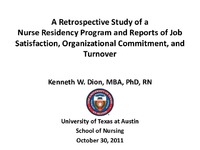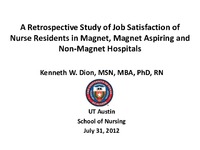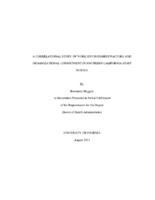| dc.contributor.author | Dion, Kenneth W. | en |
| dc.date.accessioned | 2012-01-11T10:45:47Z | |
| dc.date.available | 2012-01-11T10:45:47Z | |
| dc.date.issued | 2012-01-04 | |
| dc.identifier.uri | http://hdl.handle.net/10755/201659 | |
| dc.description | <p>41st Biennial Convention - 29 October-2 November 2011. Theme: People and Knowledge: Connecting for Global Health. Held at the Gaylord Texan Resort & Convention Center.</p> | en |
| dc.description.abstract | <p>The aging population in the United States and the need for greater access to healthcare due to recent legislative reforms will result in an increased demand for registered nurses. However, meeting this demand will challenge healthcare organizations. Furthermore, reported turnover rates of newly graduated registered nurses range from 18% to 60% during the first year of employment. Healthcare organizations implementing structured nurse residency programs have reported success in stemming the tide of new graduate turnover. However, there is limited empirical evidence in the nurse residency literature regarding variables that are related to turnover rates of newly licensed registered nurses. The purpose of this study was to examine the outcome variables of job satisfaction, organizational commitment, and turnover among newly graduated nurse residents in Magnet, Magnet Aspiring, and Non-Magnet Hospital work environments across the US. A descriptive, correlational, secondary data analysis was completed examining the outcome variables in a sample of 628 newly graduated nurses completing a structured nurse residency program in general acute care hospitals between January 1, 2007 and December 31, 2009. The findings from this study demonstrated the difference between job satisfaction at two months, six months, and 12 months among nurse residents in the different work environments. Furthermore, the influence of the residency program on organizational commitment in the context of differing work environments is reported. Moreover, turnover rates following the completion of the nurse residency were found to be lower than the national average for newly graduated nurses in all three types of nursing work environments. Finally, the relationships between the outcome variables are explicated.</p> | en |
| dc.format | Text-based Document | en |
| dc.language.iso | en_US | en |
| dc.subject | New Graduate Turnover | en |
| dc.subject | Nurse Residency | en |
| dc.subject | Work Environment | en |
| dc.title | A retrospective study of a nurse residency program and reports of job satisfaction, organizational commitment, and turnover | en |
| dc.type | Presentation | en |
| dc.rights.holder | <p>
All rights reserved by the author(s) and/or publisher(s) listed in this item record unless relinquished in whole or part by a rights notation or a Creative Commons License present in this item record.
</p><p>
All permission requests should be directed accordingly and not to the Sigma Repository.
</p><p>
All submitting authors or publishers have affirmed that when using material in their work where they do not own copyright, they have obtained permission of the copyright holder prior to submission and the rights holder has been acknowledged as necessary.
</p> | |
| dc.description.note | <p>Items submitted to a conference/event were evaluated/peer-reviewed at the time of abstract submission to the event. No other peer-review was provided prior to submission to the Henderson Repository, unless otherwise noted.</p> | |
| dc.type.category | Full-text | en |
| dc.evidence.level | N/A | en |
| dc.research.approach | N/A | en |
| dc.author.details | Kenneth W. Dion, RN, MSN, MBA, PhD | en |
| dc.conference.name | 41st Biennial Convention: People and Knowledge: Connecting for Global Health | en |
| dc.conference.host | Sigma Theta Tau International | en |
| dc.conference.location | Grapevine, Texas USA | en |
| dc.date.conferenceyear | 2011 | |
| dc.description.reviewtype | Abstract Review Only: Reviewed by Event Host | en |
| dc.description.acquisition | Proxy-submission | en |





